Oh, boy. Someone just lovingly brought you something in a shiny foil wrapper with a big bow. And it's so very pretty..............now. Well, you'll just look at the growing instructions on the tag.........which it doesn't have. What now? Never fear.
Many holiday plants aren't really meant to stay alive for long, anyway. Some are are surprisingly easy to care for. The best of them are simple to care for and can also grace your home with cheerful holiday blooms year after year. Here's my list from best to worst, based on flower power, ease of care, and potential longevity.
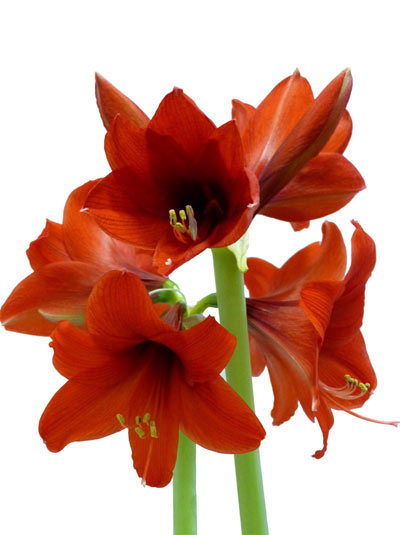
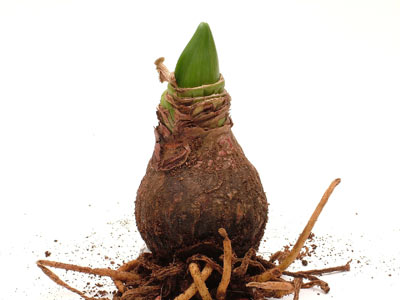
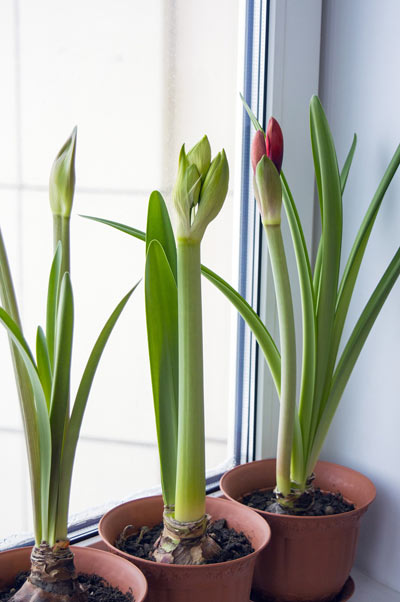 Amaryllis: Lucky you--you got an easy one! Whether received as just a bulb or a budded and blooming potted plant, Amaryllis are elegant and simple to care for, and can be easily forced to rebloom each year.
Amaryllis: Lucky you--you got an easy one! Whether received as just a bulb or a budded and blooming potted plant, Amaryllis are elegant and simple to care for, and can be easily forced to rebloom each year.
If you have a bulb, plant in a well-draining potting mix, leaving the top 1/2 to 1/3 of the bulb above the soil line. Choose a pot that is no more than 1 inch wider than the bulb, and preferably 2 times the height. Place in a sunny window and keep soil barely moist until you see new growth, then start to water whenever the top 2 inches of the soil is dry.
Once flower buds have started to open, move plant to a bright spot without direct sun, and keep at 65 degrees to maximize the floral display, but never lower than 60 while in growth. Warmer temperatures are fine, but your flowers won't last as long. If floral stems elongate too quickly provide more light & a bit less water to keep it more compact.
Once the flowers have faded cut the stems down to the top of the bulb, but don't cut the leaves back unless they look poorly. The idea now is to allow the leaves to grow to feed the plant for the next blooming cycle, as is usual with bulb plants. You can keep it inside or transition outside when temperatures won't drop below 60-65, and give it the brightest light you can. Fertilize with half strength, high phosphorous fertilizer at every other watering while new growth is present.
By mid-August you want to cut back water to just enough to keep the bulb from completely drying out, and place in a cool, dark spot. The leaves will yellow and die--that's ok! You want it to have a dormant rest for a couple of months. You can leave it in the pot or take it out. About 6-8 weeks before you want it to bloom again, repot if necessary and resume watering and lighting as before. Amaryllis bloom better when pot-bound, so you'll only need to re-pot when the bulb is tight in the pot. That's it! Every year the number of blooming stems will likely increase as the bulb grows.
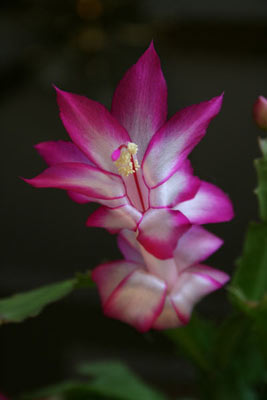
Christmas Cactus: Again, you got lucky. Everyone knows someone whose Grandma has a 30 year old Christmas Cactus -- they're truly long-lived with just a bit of basic knowledge and simple care. The most important thing to know about this new member of the family is that it does NOT come from the desert! Not a true cactus, it hails from warm, moist rainforest regions.
There it grows as an epiphyte, as do most orchids, with roots attached to tree branches. Therefore, it needs more water than a typical cactus, but not as much as a non-succulent houseplant. While blooming, keep your plant in bright, indirect light (although full sun is tolerated during winter), with room temperatures between 60 and 70 degrees. Let dry slightly between waterings. Bud drop may result from drying out, sudden changes in light or temperature, or low humidity.
Once flowers have faded, the plant will be resting until active growth resumes in spring, so cut back on bit on watering during that time. Fertilize monthly from April to October, using a high phosphorous formula in the fall. Short days and cool night temperatures trigger re-blooming in autumn. Plan on 14 hours of darkness, and/or night temperatures of 50 to 55 degrees for about 6 weeks. Night temperatures over 68 degrees will prevent blooming regardless of short daylight period, so be sure keep your plant cool.
If you've put your plant outside in a shady spot for the summer, you can leave it there until nights drop colder than 50 degrees, as long as there are no streetlights to interrupt the dark period. Christmas cactus bloom best when pot bound, so repot only every 3 years or so. If you want to continue the pass along tradition of this plant, trim stems in June and stick the cuttings in moist vermiculite until they have rooted, about 2 to 3 weeks, when you should see reddish new growth. Oh, by the way, should your "Christmas" cactus stubbornly bloom every year a month or so early, you probably have a "Thanksgiving" cactus. Growers often force both into bloom for holiday sales, and they are very similar except for which holiday they prefer!
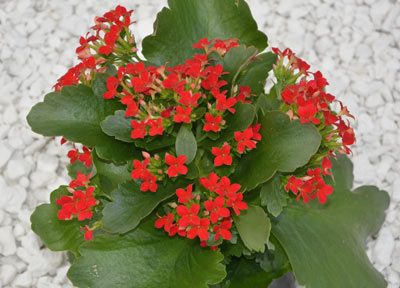
Kalanchoe: Definitely a possibility for long life, although some varieties can be harder to rebloom. Still, the shiny succulent leaves make for an attractive accent with or without flowers. Notice I said "succulent," so somebody knew you didn't have time to pamper a plant. Keep dry in winter, and water sparingly even in summer. Bright indirect light works, some direct sun is ok in winter, but leaves may burn in summer sun. Never expose kalanchoe to temperatures lower than 50 degrees. 14 to 18 hrs of darkness for 4 to 8 weeks is required to initiate bloom. And pronounce this one however you prefer, kal-an-co-ee or ka-lan-cho, take your pick. Or just name it Bob and be done with it.
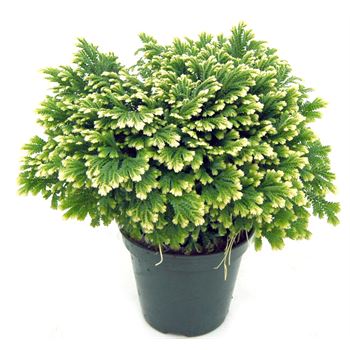 Frosty Fern: Oh, so pretty, and not really a fern. Also called spike moss, but, uh, it's not really a moss, either. But it is Selaginella kraussiana, and you can impress all your guests with that one. Still, you'll treat it pretty much like a fern--keep it moist and humid--growing in a terrarium or under one of those beautiful glass cloches is ideal. Bright light is preferred, as are temperatures between 65-70, although temperatures of 50 to 80 degrees are tolerated. One additional tip is that they don't like hard water, so use filtered or distilled if your water leaves spots on your dishes!
Frosty Fern: Oh, so pretty, and not really a fern. Also called spike moss, but, uh, it's not really a moss, either. But it is Selaginella kraussiana, and you can impress all your guests with that one. Still, you'll treat it pretty much like a fern--keep it moist and humid--growing in a terrarium or under one of those beautiful glass cloches is ideal. Bright light is preferred, as are temperatures between 65-70, although temperatures of 50 to 80 degrees are tolerated. One additional tip is that they don't like hard water, so use filtered or distilled if your water leaves spots on your dishes!
You may want to plant this little groundcover in your shade garden, but depending on what source you believe it is hardy to as far north as zone 6 or possibly only to zone 8. I have generally heard zone 7 for this one, but still think that's iffy since our winters vary so much. I've had other Selaginella species that did not return in my garden even though the grower claimed zone 7 hardiness. Zone 8 seems safest, since growers always push the zones so more of us will try (buy) something. If you have a larger plant, try dividing it in spring and repotting one for that cloche, and let the other brighten up that dark corner near your hosta.
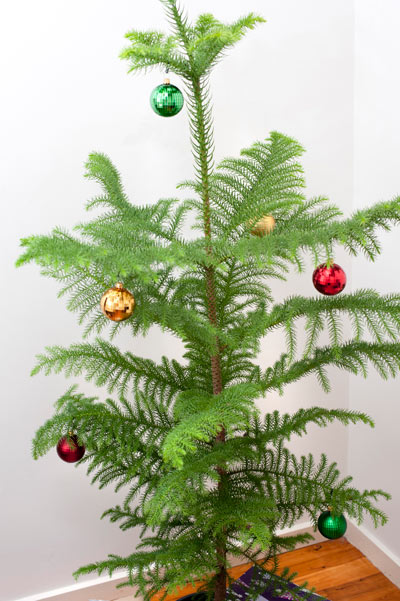 Norfolk Island Pine: Well, you've actually been given a very graceful houseplant you should be able to enjoy for many years. In fact, Norfolk Island Pines have been know to live for 150 years, so you might want to put it in your will. Don't plan on planting this one in the back yard, though, unless you live in a tropical clime. Not a true pine, they cannot tolerate temperatures below 35 degrees. And although they can grow up to 200 feet in their native habitat, they generally top out at about 20 feet indoors, and 6 to 10 feet is more likely.
Norfolk Island Pine: Well, you've actually been given a very graceful houseplant you should be able to enjoy for many years. In fact, Norfolk Island Pines have been know to live for 150 years, so you might want to put it in your will. Don't plan on planting this one in the back yard, though, unless you live in a tropical clime. Not a true pine, they cannot tolerate temperatures below 35 degrees. And although they can grow up to 200 feet in their native habitat, they generally top out at about 20 feet indoors, and 6 to 10 feet is more likely.
They prefer bright direct to bright indirect light and high humidity--which means don't put them in that dark corner next to the heat vent. Water throughly when the surface is dry to the touch, except during the winter rest period when you should wait until the top inch of soil is dry. Fertilize spring through fall with a balanced houseplant fertilizer according to directions. Bottom branches may drop with sudden changes in culture--lower light, lack of water, or hot or cold drafts. Roots are slow growing, so repot into a well-draining potting mix, such as one used for succulents, only when roots grow through the holes in the pot. And guess what--you'll have a live Christmas tree to decorate inside every year!


Poinsettia: Just do what everyone else does and toss it after you sing Auld Lang Syne. While you have it, keep in bright filtered light and don't expose to temperatures lower than 50 degrees--even for a minute. Cold damage on poinsettias tends not to be immediate, showing up the next day as a wilted looking plant with seemingly no explanation. Let dry slightly between waterings and NEVER let the pot sit in water. Don't ever mist or water a poinsettia from above--water will spot the bracts and likely cause disease. Keep away from heat vents and cold drafts.
Cared for properly, they can easily last a couple of months. Varieties with thicker, curly bracts, such as Carousel and Winter Rose, can last much longer. It's a real pain to "rebloom" a poinsettia, and they rarely look as good as a new plant. If you have one that still hanging around and want to give it a shot, then cut back plant to about 5 inches in spring and repot. Move into bright direct light when you see new growth. You can put your plant outside in part sun for summer. Pinch stems for compact growth and more colorful bracts through summer, but stop by the beginning of September. Mid-September, install your project in direct light in a room with night temperatures of 65 degrees, and give it total darkness for 12 hours a day (or night, rather). NO light can enter the room--from streetlights, lights from other rooms, etc. It may be easier to put a box over the plant. If all goes well, you should see your plant begin to color up sometime at the beginning of December. Then you can re-gift to the person who gave it to you!
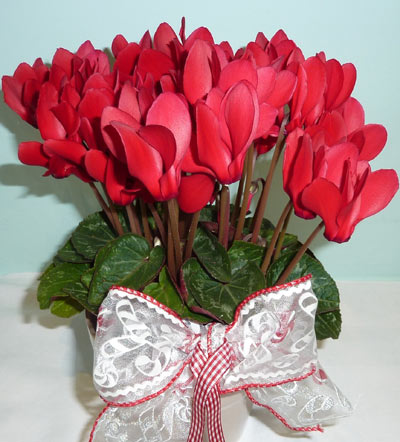
Cyclamen: Oh, what a thoughtful........thing that's going to drive me crazy until I throw it away. And it smells so good, too! But cyclamen really are lovely, and I only rate them slightly below the poinsettia since they just can't compete with the poinsettia's overall decorative value. And maybe because they're going to do what looks like dying no matter what you do, but unless you read this you won't know that. While there are hardy species cyclamen that can grow outside in zones 5 through 8, your gift plant is a florist's cyclamen, a frost-tender hybrid with a broader color range and much larger flowers.
These need bright indirect light, moderate humidity, and cool room temperatures to prolong flowering--no more than 68 degrees during the day, and preferably down into the 50's at night. They go dormant in warmer temperatures, and also after flowering no matter what the temperature--that's what looks like dying to the innocent and uninformed. Watering can be tricky, as the corms from which they grow have a depression in the top which can hold water, causing rot. You may carefully water from the sides, but NEVER overhead to avoid filling that depression with water. Alternatively you can bottom water--sitting plant in a saucer of water until soil is moistened, but not longer than 30 minutes or so. Keep plants moist but not wet. Fertilize with high phosphorous fertilizer every 2 weeks during the growing season. Once flowering is finished, leaves will wither and the plant will go dormant, usually by spring. Let the plant stay almost completely dry for summer. If you're lucky, you may see new growth begin in fall, when you should start to water and fertilize as before.
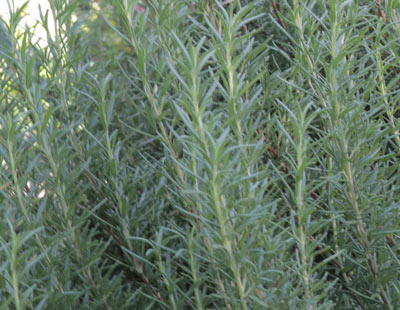
Rosemary Tree: Oh, you have been gifted the plant of death. Hang it upside down and let it dry, use the dried rosemary for cooking, and save yourself a lot of heartache. Or, you can plant it outside IF you are zone 8 (maybe 7--plant close to the house or in a sheltered, sunny position) or south. The type of rosemary usually used for topiary is not one of the cold-hardier varieties. Of all the plants that people buy for the holidays, this is the one that never seems to still be around a year (or 3 months) later.
You will read things on the internet that tell you how easy they are to grow, and you may even read that on the pretty little tag. Don't believe it. But if you want to try, read on. Almost every rosemary topiary tree you buy will be rootbound when you buy it--they grow slowly, and have to be in those pots for too long to be so full and so well shaped. So I've learned that the first thing to do is to loosen the roots and repot into a slightly larger pot--no more than an inch bigger than the one it came in. After that you have to keep it moist, BUT NOT WET, and NEVER let it dry out. This is one that does not wilt to let you know it is dry, and once it IS dry the leaves will just fall off.
It likes high humidity, so keep away from heat vents, preferably in a cooler room. Give it 14 hours of light daily, with as much direct sun as possible. Watch out for the very likely powdery mildew, which looks like a white or gray coating on the leaves. Treat with horticultural oil at the first sign. Stem dieback and uneven browning usually indicates root rot from over watering. Are you exhausted yet? If you get it through the winter, transition slowly to the outdoors as soon as temperatures are solidly above 40, then you'll need to do the same in the fall to bring back inside. Did I mention that rosemary is really good with chicken? Just because the plant is dead doesn't mean it doesn't still have some flavor. Just sayin'.
Tips for keeping all your gift plants happy and healthy:
- Get it out of whatever pretty wrapper it came in--NOW. Or, do what I used to do--punch holes in that pretty wrapper so the plant NEVER sits in water. Same thing with that saucer under your plant--that is there to protect your furniture, NOT to provide extra water to your plant. Only bog and pond plants want their roots sitting in water for long periods of time--with other plants it causes root rot. Plants also appreciate air flow around their roots, so the saucer is highly preferable to the wrapper. And please, I know they make pots with no holes, but either pretend they are simply a tall saucer and keep the water emptied out, or just use them for soup. The people that make pots know about pots, not plants.
- Bright filtered light means sun coming through something like sheer curtains. Bright indirect light is usually found close to an east or west window or within two or so feet of a south window, with no trees or buildings blocking the light from outside. Direct sun is just what it sounds like--if you place your hand between the sun and the plant you should see a distinct shadow. Note that the angle of the sun will change throughout the year, so placement may need to be adjusted.
- Some plants just need more humidity, so if humidity drops below 50 percent they may suffer browning tips or other damage. To increase humidity there are several measures you may take. Simply grouping plants together will help. You may also place plants on individual or one large saucer, filled with pebbles which is kept filled with water just up to the top of the pebble layer. The idea is that as the water evaporates it will raise the humidity. The plants should be ON the pebbles, but NOT in water. Crescent Gardens Pebble Caddy is ideal for both grouping plants and using the pebble & water trick. Another tip is to place the plant inside a larger pot filled with sphagnum moss that is kept moist. Do not pile the moss up against the stems of the plant, just around it. Again, be sure the roots do not sit in water that may collect in the outer pot if it does not have holes.
- "Watering" means thorough watering, until water just begins to flow out of the holes in the pot. Watering fully and letting the plant dry somewhat before the next watering is the general rule for most plants. This ensures all of the root zone gets water, but plants are not oversaturated. If you fertilize, thorough waterings in between also prevent salts from building up and damaging the root zone.
- Always acclimate. Rare is the plant that can tolerate sudden, extreme changes in light, water, or temperature. Always move plants into shade first when moving outside, even if they have been growing in full sun inside. Move from sun into shade before taking plants inside for winter, as well. Plants moved suddenly from sun to shade will often shed those sun-grown leaves, trading for newly grown leaves that will photosynthesize efficiently in a lower light environment. (This is often what happens with those rosemary trees that just can't get enough light inside!). Cold acclimation is especially important when plants are going outside in spring. Put plants outside on warm days and bring in at night. Most tropical plants should not make that move until temperatures are solidly over 50 degrees.
- Most plants rest a bit during winter, due to less intense light levels. This means you should cut back on watering and cease fertilizing until growth picks up again in spring.


